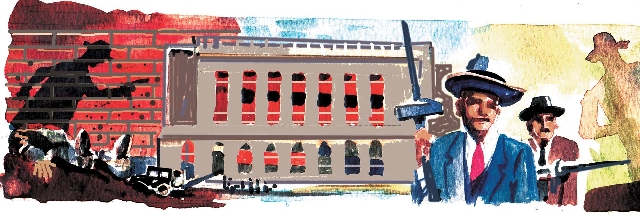Downtown museum displays mob’s greatest hits

A hit from the beginning, the Mob Museum in downtown Las Vegas celebrated its first year of operation this month on the anniversary of the infamous St. Valentine’s Day Massacre in 1929.
Officially named the National Museum of Organized Crime and Law Enforcement, the attraction keeps crowds of visitors moving through absorbing displays, multimedia segments and lively interactive exhibits.
Museum designers utilized all three floors of the building that formerly housed the city’s federal courthouse and main post office.
Built in 1933, this neoclassical structure is listed on both the state and national registers of historic places. In 1950, it was the site of one of 14 hearings held by the U.S. Senate’s Kefauver Committee. These hearings on organized crime in the United States were held in cities with known mob involvement.
The former courthouse underwent extensive renovation for its new role as a museum. Most of its 41,000 square feet of interior space was utilized.
The nonprofit Mob Museum represents an investment of $42 million by the city of Las Vegas, including $9 million in historical preservation grants from local, state and federal sources.
The main-floor post office appears much as it did when the courthouse opened 80 years ago with its period fixtures intact. Throughout the building, beautiful original structural and decorative elements have been repaired, refurbished, painted and polished. Notice the classical ceilings, stair rails, woodwork, light fixtures and other details. In the courtroom, all the seating, furniture and flooring are original. Iconic national symbols in the white plaster cornices are decorated in red and blue.
To reach the Mob Museum, follow Stewart Avenue between Fourth Street and Las Vegas Boulevard. The museum is at the north end of Third Street. On-street parking downtown is metered. Free, on-street parking on Third is intended for patrons of businesses and restaurants in those blocks. Paid parking is available in a small lot next to the museum and in several parking garages downtown.
The museum encompasses a big space, so plan your visit accordingly. It is likely to be more crowded in the afternoon.
Take an elevator or climb the stairs to start your self-guided tour on the third floor. Take time to view all of the short film presentations, which are repeated frequently in areas with various kinds of themed seating.
Wear comfortable shoes as you’ll do plenty of walking. The museum’s entrance and exhibits are handicap accessible.
The museum is a bargain for Nevada residents, who pay an adult admission charge of $10, compared with $19.95 for nonresidents. It is open 10 a.m. to 7 p.m. Sundays through Thursdays and stays open an hour later on Fridays and Saturdays.
The museum welcomes children, but parents and teachers should be aware that some of the images on display are quite graphic. The museum recommends that visiting school groups be at least in sixth grade.
While touring the shrine, visitors can learn lessons in history, sociology and the workings of government and law enforcement.
A favorite with many visitors, the second-floor courtroom comes to life as films from the Kefauver Committee hearings play. Almost holographic, images appear and speak at the podium, desks or tables where the participants sat more than 60 years ago.
Margo Bartlett Pesek’s Trip of the Week column appears on Sundays.